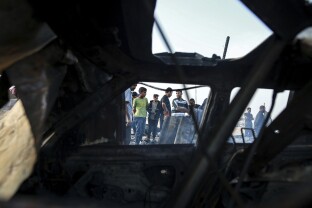Under United States military standards, Israel’s deadly strike in Rafah in late May would have required the country to deliberately accept a risk to civilian lives, U.S. military materials reviewed by NOTUS show.
According to Israel Defense Forces social media and U.S. Department of Defense documents, the May 26 strike, which was responsible for the deaths of more than 40 civilians, was planned only 180 meters from known refugee shelters and well within what the Department of Defense calls “Danger Close.”
A strike within that distance would have needed the express approval of an “on-scene ground commander” under U.S. military standards because of the high risk it poses to civilian life, per a U.S. Air Combat Command spokesperson. Weapons experts and visual evidence analyzed by multiple news outlets confirmed that the bombs used in the Rafah strike were American-made GBU-39 bombs. Those weapons have a risk distance of 200 meters, according to U.S. military documents reviewed by NOTUS.
Israel has its own standards for military engagement, but the tight relationship between the IDF and the U.S. military gives the U.S. standards weight. The IDF has trained with the U.S. military on numerous occasions. U.S. training programs for partner forces are reviewed every three to four years to ensure they meet the Air Force’s standards, including how to mitigate risk to civilians and friendly forces, per the Air Combat Command spokesperson.
National Security Council spokesperson John Kirby said Israel’s strike was “heartbreaking” before comparing the attack to strikes the U.S. had previously made in Iraq and Afghanistan, emphasizing that the United States expects Israel to hold itself to a similar accountability standard.
“We have conducted airstrikes in places like Iraq and Afghanistan, where tragically we caused civilian casualties. We did the same thing,” he said. According to the Department of Defense, U.S. officials were not notified before the strike. NOTUS could not verify whether the IDF followed U.S. protocols on the strike in Rafah.
Israel’s prime minister, Benjamin Netanyahu, called the civilian deaths a “tragic mistake” after receiving widespread condemnation for the strike on what the Israel Defense Forces said was a Hamas target. Still, according to reporting by the Associated Press, Israel carried out airstrikes and shelling in the same area less than 72 hours later, killing an additional 37 people.
Israel’s preliminary investigation suggested that a secondary explosion, possibly from an ammunition cache, was responsible for civilian deaths on May 26. It also suggested, however, that the munitions used in the airstrikes were too small to cause the additional damage, something Department of Defense documents suggest is not true of most GBU-39 strikes.
The Biden administration said it expects Israel to hold itself accountable for the civilian deaths.
“We owned up to it, we investigated it, and we tried to make changes to the way — we tried to learn from it to make changes so that those set of mistakes wouldn’t happen again,” Kirby said of the U.S. strikes in Iraq and Afghanistan. “We atone for it, we learn from it, and we put in place procedures to try to prevent that from happening again. And that’s what our expectations would be in this case.”
After killing seven World Central Kitchen aid workers in Gaza, Israel fired two commanders in the Israel Defense Forces. Both cases were sent to Israel’s military judge advocate system. The Israeli military has refused to disclose a list of investigations but committed to promptly publishing its findings.
According to Amnesty International, “the Israeli military has flouted international law, killing Palestinian civilians with total impunity and displaying a callous disregard for human lives.” The U.S. Department of State’s own report showed that intelligence professionals across the government thought Israel “could be doing more to reduce civilian harm.”
—
John T. Seward is a NOTUS reporter and an Allbritton Journalism Institute fellow.
Sign in
Log into your free account with your email. Don’t have one?
Check your email for a one-time code.
We sent a 4-digit code to . Enter the pin to confirm your account.
New code will be available in 1:00
Let’s try this again.
We encountered an error with the passcode sent to . Please reenter your email.


